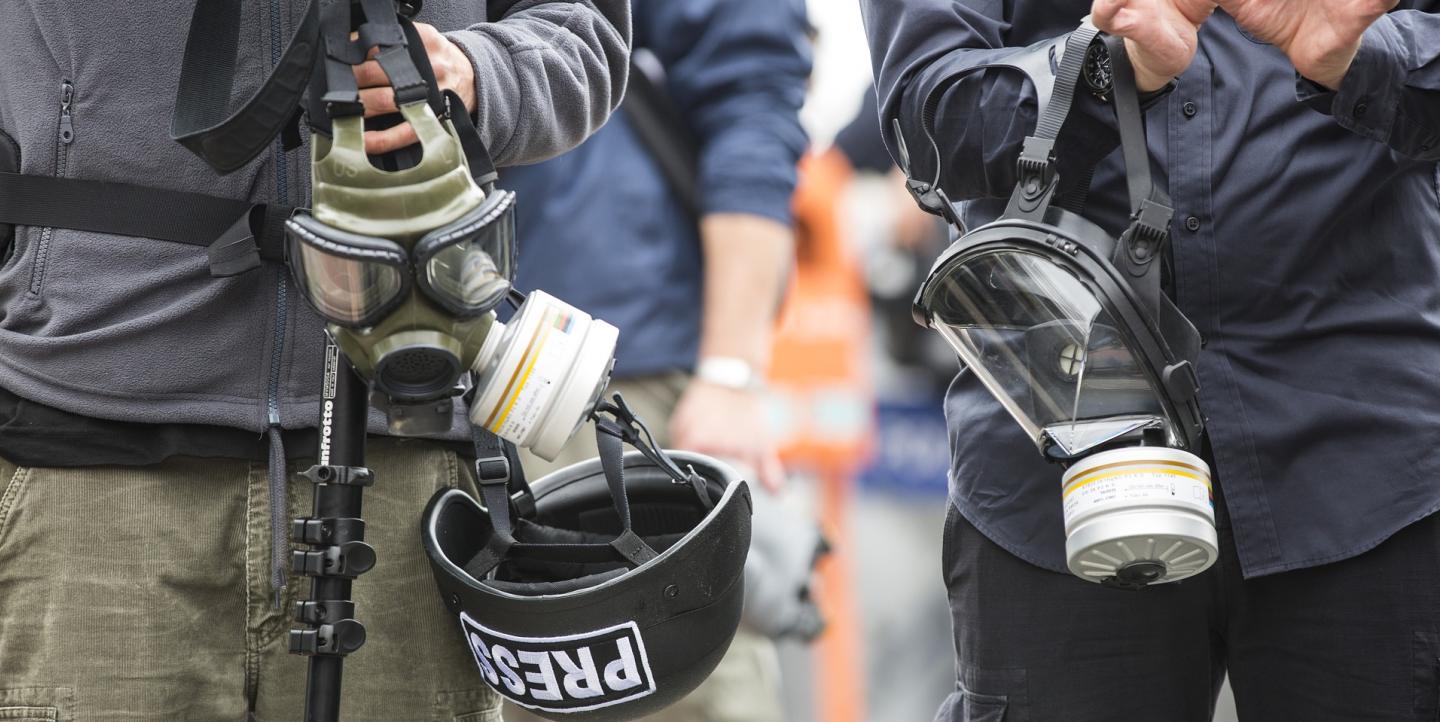Journalists can be prime targets when reporting in conflict zones. By relaying critical information on the ground, and by revealing stories of atrocities and war crimes, journalists can be at risk by those who want the facts of the conflict hidden, said Abeer Saady, a trainer and media specialist in conflict zones, during a recent ICFJ Pamela Howard Forum on Global Crisis Reporting webinar.
“During conflict, the truth is the first casualty,” said Saady.
It is a very real possibility that journalists can go missing, be detained, or lose their lives while reporting on conflict. This is seen not only during the Russian invasion of Ukraine, but also other conflicts around the world. At the same time, some journalists are at an even higher risk because of their identity, such as gender or ethnicity, in a given conflict zone, said Saady.
As journalists have become conflict correspondents overnight in Ukraine, it’s important that they also safeguard their physical, digital and mental wellbeing. Here are some highlights from the webinar on how journalists can keep themselves safe while reporting on conflict:
Physical safety
In a conflict zone, the most immediate risk to a journalist is physical threats, said Saady. When the physical risk is high, it’s important to know when to stop reporting and get to safety.
Journalists should always wear protective equipment. They should be aware of the weapons being used around them, and develop an escape plan for areas where they are reporting.
First aid training and a basic understanding of map reading can also be helpful.Reporters should also take care not to reveal their location to individuals or groups they don’t trust. “Never risk yourself for the story,” said Saady.
In conflict zones, safety can be a daily struggle. Local reporters, regardless of work experience, especially can face hostile environments even in their own hometowns due to impunity. Having a local network, such as fellow journalists, community members, translators, and security experts, is a helpful way to improve safety. “You have to know who to trust,” Saady said.
Using fixers, understanding the local culture, and finding patterns for safe and fast mobility, and working as part of a journalism team can also help. Many local and international organizations also provide aid and equipment for journalists operating in conflict zones.
Mental safety
Threats to journalists are not exclusively physical – the mental health of journalists working in war zones is also at risk. Keeping on top of the stress of reporting and maintaining emotional stability can be just as important as physical safety.
“Do not underestimate this stress,” Saady said. “You are in survivor mode, and you do not really think about the types of stress and what the people around you are going through.”
Mental stress doesn’t just affect journalists on the frontlines. “Psychological safety is not only about the journalists who are journalists in the battle, but those who are outside.” she said. “Sometimes when you are outside of it and your loved ones are inside, this is a big pressure because you feel guilty.”
Saady warns that emotional reaction to a conflict can also impair physical safety. “Try not to get emotionally involved in the coverage,” she said, for instance assisting others at the risk of your own personal safety.
Some international organizations offer mental health resources and workshops for journalists to better prepare them for reporting on traumatic events.
Digital safety
Developing a communication plan is imperative when reporting in a conflict zone. Having multiple telephones or a satellite phone, and ensuring that all of your devices have backup power sources, are must-have preparations for reporting.
Having a trusted contact on the outside of the conflict zones who is knowledgeable about local geography, and who is following up and keeping updated on developments, is also an important precaution.
Ensure you use encrypted messaging apps like Signal, and that you secure and back up your data, as devices can be lost or stolen. Keeping sensitive data, such as source contact details or other information that could jeopardize another’s safety, in secure places is also paramount. “When I am in the conflict zone, anyone can stop me, anyone can take my computer or mobile. The less information you are carrying around, the better.”
Journalists must also be prepared in the event communication infrastructure collapses. “You will be in danger, and no one will know where you are,” Saady warned. “You have to know what kind of communication is available, and if you have it or not.”
Knowing these options in advance and having a plan for if phone or internet communications fail can help journalists know how to reconnect with outside contacts and plan next steps.
Everything in conflict reporting is about risk, and accepting and minimizing is paramount. By preparing for risk, analyzing potential threats and being prepared to make safety decisions in the heat of the moment, journalists can if not completely ensure safety at least be best prepared for the uncertainties of reporting in a conflict zone.
“You can’t control danger, but you can control risks,” Saady said.
Photo by Engin_Akyurt on Pixabay.


